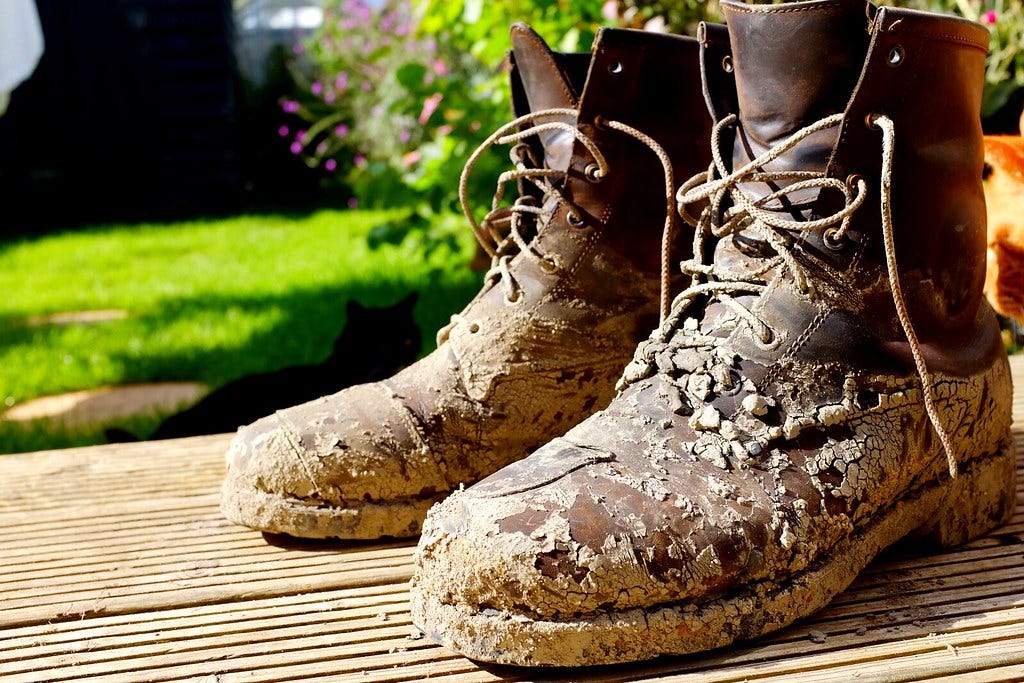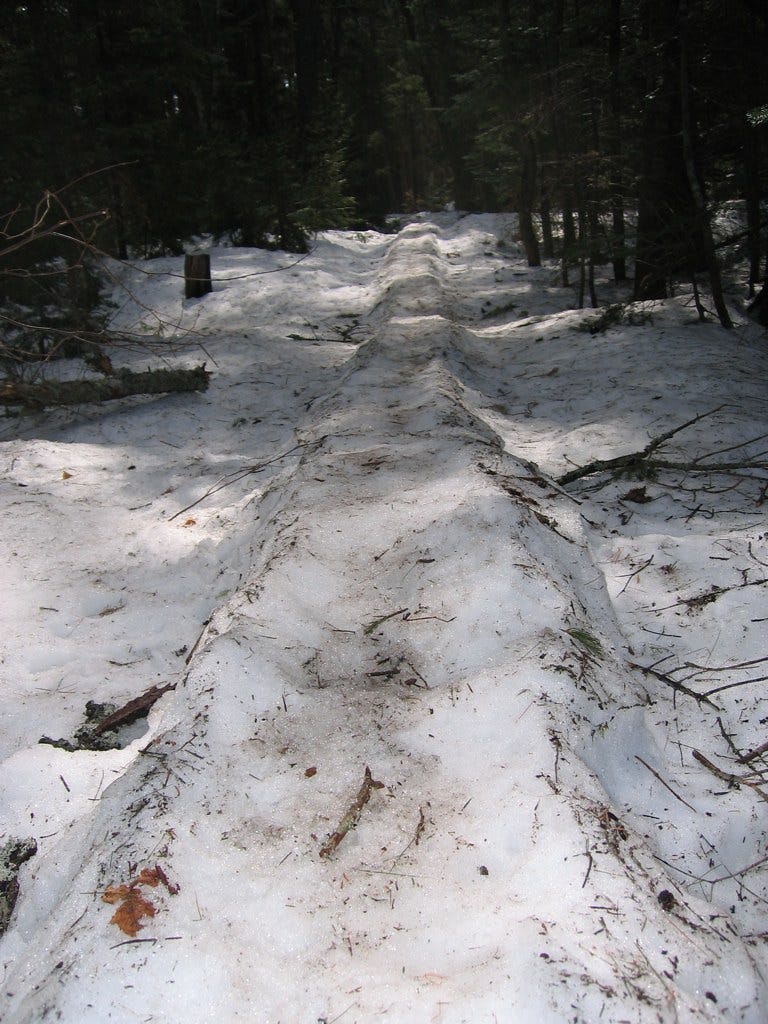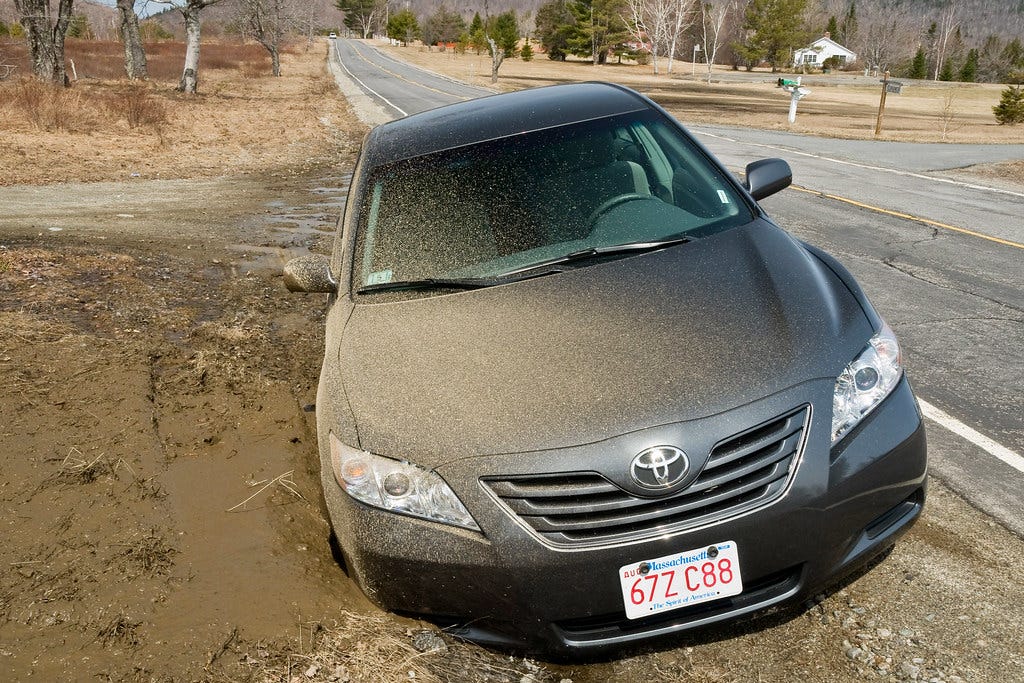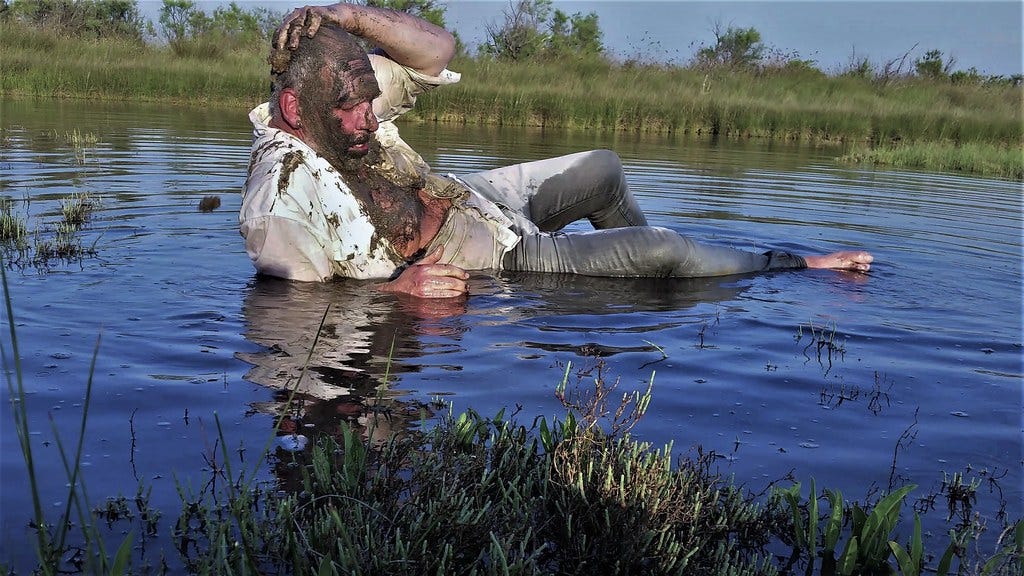The new primordial soup
The unexpected ecstasy of Mud Season
The new consensus seems to be that New England winter is too long. Why else would the Senate (the Senate!) pass a bill to make daylight savings permanent—a policy that would mostly benefit the northeast? I’m for it, because I get it. Winters really overstay their welcome in these parts. You can adore snow to the point where you put it in your coffee and still feel fatigued by the time March rolls around. You’ve spent too much time indoors nursing chapped sunlight-deprived skin back to health. Your muscles have atrophied from under-use. Eating an entire loaf of Challah is losing its novelty.
So you start drawing up hiking plans for summer. A little Acadia here, a couple Green Mountain state parks there, a foray to Pinkham Notch to climb the Wildcats, etc. It’s serviceable as a late winter tonic, but A: summer is still at least a month away, and B: to focus on June and beyond is to overlook one of the most ecstatic periods in New England’s seasonal life cycle. I’m talking about NEW ENGLAND MUD SEASON.
By mid-April, all those snowdrifts in the mountains and hills are melting and turning the frozen ground into a new primordial soup. This tide of mud is an olfactory wonder, covering a range of scents that can range from spruce to squirrel shit. At times you can watch the mud slowly flowing down hillsides past just-thawed evergreens and moss. Enter the woods during this seasonal transition and guess what? You’re going to get pretty muddy yourself. You’re going to need a change of footwear and a shower after your hike. But after the prolonged constrictions of winter, there’s a catharsis to getting covered with mud, knowing that the world is coming back to life and you’re covered in it.
I recently found this video in which Eric Orff, a resident of New Hampshire, describes mud season as a fire hose of biological resurgence. “River Herring, spiders, frogs, salamanders, duck, geese and more are pouring from the ground, air and water RIGHT NOW,” Orff said. And you don’t have to take his word for it. Hiking during mud season can involve witnessing young plants and baby animals adapting to soupy woodlands. When I was a backcountry hut caretaker in the Zealand Valley near Crawford Notch, New Hampshire, I got to experience this each time I made the eight mile hike down the Zealand Trail and the gated access road to the valley (to pick up more groceries for the week.) I saw actual pint-sized pine martens, red squirrels that were starting to emit their tinny battle cries, and at one nerve-shredding point, a lone bear cub.
These messy hikes—after which I’d leave my boots to dry for a few days, so I could shake the mud off later—made me think about the ways in which mud is often associated with healing, deliverance, and release. I’m far from the only person with a soft spot for mud. Humans have dipped themselves in spa-curated mud for centuries, taking advantage of its ability to exfoliate and draw out impurities. In Predator, Arnold Schwarzenegger hides in a mud slick to avoid having his skull turned into a trophy by an extraterrestrial game hunter. (The alien, which detects the body temperatures of its prey, can’t spot him in the mud.) The Governator spends the rest of the movie shirtless but smeared with mud, right up to the final mano a mano with the interstellar beast.
But the surprising joy of mud season most reminds me of Nine Inch Nails’ performance at Woodstock 1994. Trent Reznor and Co. were embarrassed by the corporate takeover of the Woodstock name, only having agreed to play the resuscitated festival because the fee would help them recoup their tour costs. But shortly before their set, the band got into a playful scrap in the mud behind the stage. Torrential rain had created a localized mud season on the festival grounds, and instead of cleaning off, Nine Inch Nails went out there and performed their show covered from head to toe in mud. It electrified the audience, giving an impression that people were witnessing a release of feral energy, and it remains one of the definitive live music performances of the 1990s.
This could be you! A solid mud season hike between now and late May can leave you looking just as filthy as good old Trent here, but in a more serene state. And to get you pointed in the right direction, I’ve compiled a shortlist of mud season caveats and trail tips to practice. As with any New England season, there are unique quirks and a few natural hazards to bear in mind before pulling on your waterpoof boots or trail shoes. But compared to the endless wind and short days of January, mud season is a treat—a musky gelato of a hiking season, after a miasma of lethargy and repression.
TIP #1: STAY LOW. Mud season hikes are going to be a lot more pleasant at lower altitudes. In the boreal forest and in the exposed alpine zone, you’ll still find plenty of rotting snow and ice lingering on trails between now and June. Not only is this stuff slick but it’s also liable to give way under footsteps. You don’t want to snap an ankle like a twig anywhere, but you really don’t want to do this at high altitude during a time when most hikers haven’t made their way up to the summits yet.
TIP #2: CALL AHEAD. Mud season hiking can be a little controversial in some hiking forums. Why? Because certain muddy trails are vulnerable to damage when wet. This tends to be more of an issue in areas that see tremendous snow accumulation over the winter (primarily in north New England.) Organizations that maintain trail systems may put out disclaimers urging people to temporarily avoid certain trails that are in a very muddy state. So if you’re planning to head to a specific region of New England for a spring hike, it’s a good idea to look up the trail(s) you’re planning to take, find out who manages them, and check their website or social media pages for mud updates.
TIP #3: MIND THE ROADS. The trick to hiking on a muddy trail without inflicting real damage upon the trail is to simply stay on it, even if the trail gets seriously muddy in places. (Walking around thick mud patches on adjacent ground can widen the trail.) Muddy trailhead access roads are another story. Freshly-thawed dirt roads—especially the roads which are overdue for a grading—can be a real problem for hikers. If you’ve got a low clearance vehicle like I do, you can literally get trapped on one of these dirt roads if your wheels sink into the mud, an embarrassing and potentially expensive predicament. My advice: stick to trailheads that are accessible by pavement, and keep an eye peeled for frost-heaves. These natural speed bumps are the result of shifting ice beneath the paved road. You do not want to hit one at high speed.
TIP #4: BEWARE THE WATER. Most lower elevation hikes are going to be fitting for mud season, but the one exception is hikes that involve lots of water crossings. Hikers are generally aware that snowmelt can lead to much higher water levels in streams and brooks, but what often catches folks off-guard is just how quickly water levels might change: especially if you’re undertaking a full day’s hike. The waterway that you rock hopped across at 10am might be impassable upon your return later in the afternoon if enough snow has been melting in the nearby highlands, or if it’s rained recently. Last year, a hiker who ran into this problem in the Adirondacks had to be rescued after crossing several streams and edging dangerously close to hypothermia. This brings us to the final and simplest mud season caveat…
TIP #5: DRESS LIBERALLY. The beauty of spring weather is that it’s all over the place: radiant and toasty in one hour, only to become soggy and glowering the next. If you’re caught outdoors during these ambivalent weather patterns without the proper clothes, the beauty of mud season can transform into outright misery. It might seem like overkill to bring a backpack large enough to carry a rain jacket, a fleece or similar thermal top, your hat and gloves, and an extra shirt (along with your requisite snacks and emergency supplies.) But mud season is the segue from winter: not the definitive end of it. The temperature could still drop. A mid-May dusting of snow is not unheard of. So bring enough hiking clothing for two seasons, in a vessel voluminous enough to accommodate it all, and you’ll be in a better position to enjoy being muddy and unpresentable.







